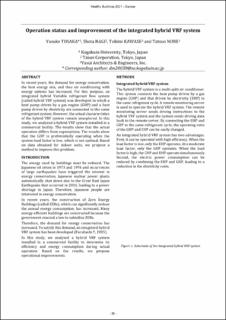| dc.contributor.author | Tosaka, Yusuke | |
| dc.contributor.author | Hagi, Shota | |
| dc.contributor.author | Kawase, Tokimi | |
| dc.contributor.author | Nobe, Tatsuo | |
| dc.date.accessioned | 2022-01-25T10:46:10Z | |
| dc.date.available | 2022-01-25T10:46:10Z | |
| dc.date.issued | 2021 | |
| dc.identifier.isbn | 978-82-536-1728-2 | |
| dc.identifier.issn | 2387-4295 | |
| dc.identifier.uri | https://hdl.handle.net/11250/2839171 | |
| dc.description.abstract | In recent years, the demand for energy conservation, the best energy mix, and thus air conditioning with energy options has increased. For this purpose, an integrated hybrid Variable refrigerant flow system (called hybrid VRF system) was developed in which a heat pump driven by a gas engine (GHP) and a heat pump driven by electricity are connected to the same refrigerant system. However, the actual characteristics of the hybrid VRF system remain unexplored. In this study, we analyzed a hybrid VRF system installed in a commercial facility. The results show that the actual operation differs from expectations. The results show that the GHP is preferentially operating when the system load factor is low, which is not optimal. Based on data obtained for indoor units, we propose a method to improve this problem. | |
| dc.language.iso | eng | |
| dc.publisher | SINTEF Academic Press | |
| dc.relation.ispartof | Healthy Buildings 2021 – Europe. Proceedings of the 17th International Healthy Buildings Conference 21–23 June 2021 | |
| dc.relation.ispartofseries | SINTEF Proceedings;9 | |
| dc.rights | CC BY 4.0 | |
| dc.rights.uri | https://creativecommons.org/licenses/by/4.0/ | |
| dc.title | Operation status and improvement of the integrated hybrid VRF system | |
| dc.type | Chapter | |
| dc.type | Peer reviewed | |
| dc.type | Conference object | |
| dc.description.version | publishedVersion | |
| dc.rights.holder | © 2021 The Authors. Published by SINTEF Academic Press. | |
| dc.subject.nsi | VDP::Teknologi: 500 | |

